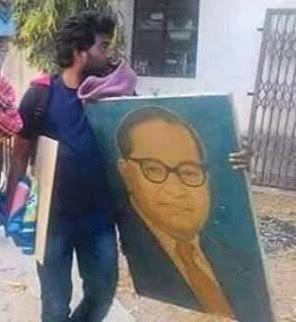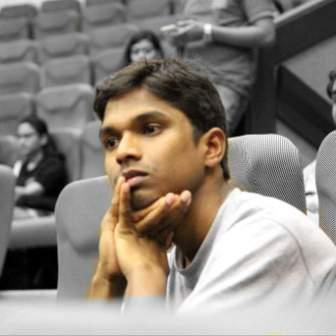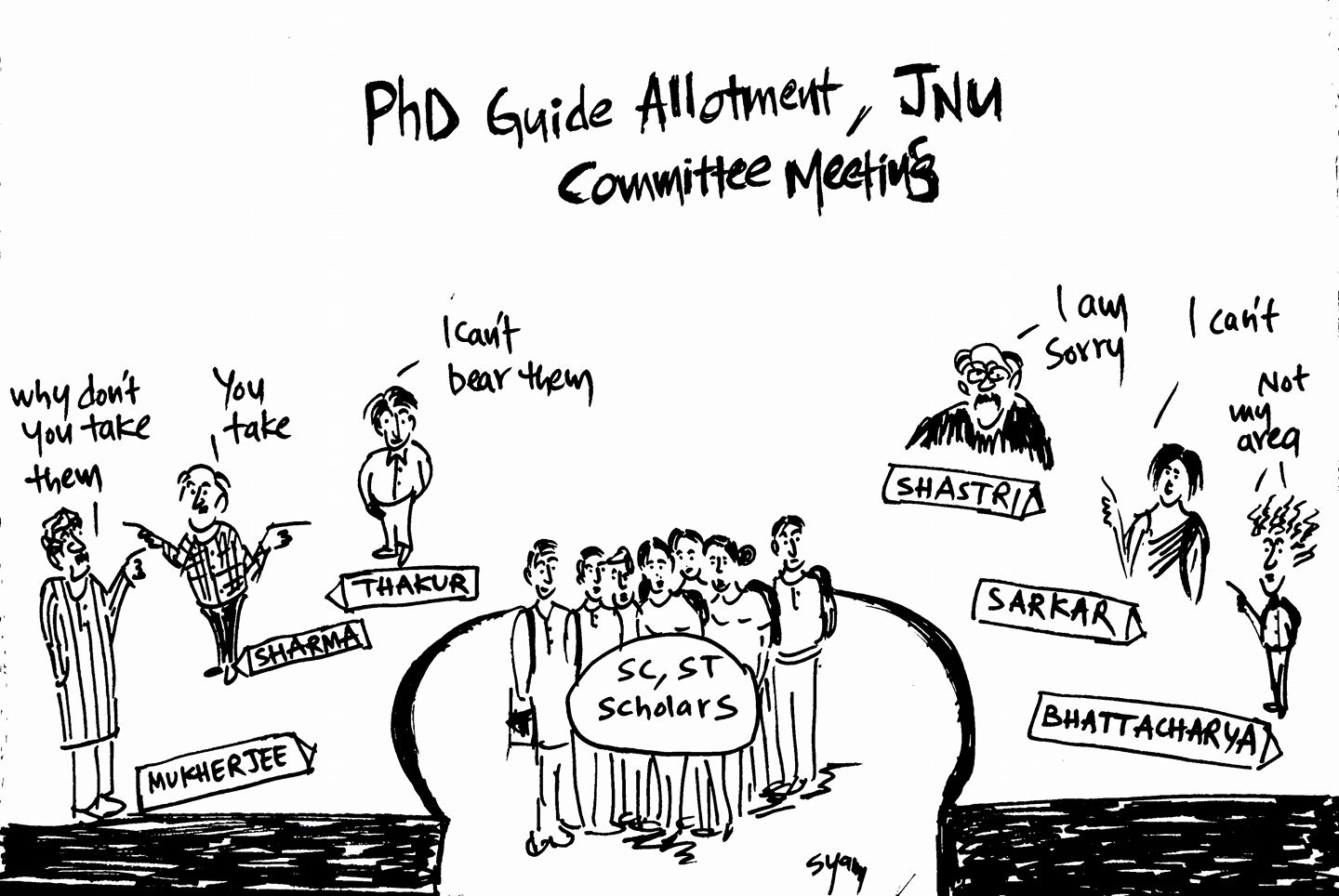Dr. Sylvia Karpagam
 The presence of brahmins as key decision makers in India has adversely affected our progress on many fronts. Their deep-rooted social, cultural and religious mindset often persists inspite of contrary scientific, social or humanitarian logic. If India really wants to and needs to progress at a pace that is appropriate and necessary, then brahmins should be actively taken out of certain key spaces.
The presence of brahmins as key decision makers in India has adversely affected our progress on many fronts. Their deep-rooted social, cultural and religious mindset often persists inspite of contrary scientific, social or humanitarian logic. If India really wants to and needs to progress at a pace that is appropriate and necessary, then brahmins should be actively taken out of certain key spaces.
For a start, brahmin bureaucrats are a barrier to implementing any scheme that will allow India to quickly address its pressing social inequalities such as poverty, caste discrimination, poor education, ill-health, malnutrition, unemployment etc. They would not want a situation where all young people have opportunities for employment, all children have opportunities to study in good and free public schools, all women have access to good quality nutrition and other benefits that keep them healthy and happy, and all families have social support systems to help them aspire towards larger and better things. It goes against the grain of the brahmin bureaucrat to do things that remove inequality, injustice and discrimination, which are the pillars of the caste system. If all Indians were given equal opportunities, then who would be left at the lower rungs of the caste system? This is more cause for concern for the brahmin bureaucrat than any scheme aimed at improving the condition of India’s citizens.
Those brahmins who have occupied most positions in the education system and academia, actively and passively encourage all forms of discrimination which are detrimental to our educational progress, to flourish rampantly. They wouldn’t object when funds are cut to public institutions because they intrinsically believe that non-brahmin children shouldn’t really be educated. How can someone who doesn’t believe in universal education, genuinely fight for it? A brahmin fighting for universal education would be like a cow fighting for beef pickle, and that is why our educational systems are so weak and our children struggling to reach even one small fraction of their vast potential. Brahmin teachers are more than happy to repeatedly tell non-brahmin children that they cannot be taught because they are not brahmins and that their place is outside the classroom, working (read slaving) for the brahmin. One doesn’t need to have a very big IQ to understand that this can damage a child’s sense of self-esteem and creates an unequal world, but since that is precisely what the brahmin desires, it is precisely the reason why no brahmin should be allowed into educational institutions as teachers, principals or anyone remotely connected to teaching children. Clearly what they teach children currently are not things we want our children to learn.
The Indian Institutes of Management are large agraharas that gate keep and allow only their own ilk to enter their hallowed gates. This means generations of bright non-brahmin men and women would never have a chance to do Phds and Masters or become faculty in these institutions. They will never be allowed to bring in their own rich knowledge and experiences. Instead the same jaded brahmanical narrow-minded understandings will reverberate along the walls of these institutions forever and ever unless some serious interventions are put into place.
Research is one domain that brahmins should definitely be kept out of. Brahmin researchers are past masters at the art of appropriating the rich knowledge and tradition of non-brahmin communities and making life time careers out of it. The brahmin researcher and academician will convert even the simplest data to excruciatingly complex analysis that often borders on jargon, so that their positions as knowledge holders are perpetually upheld. What would the brahmin knowledge holder do if people started challenging their research, or even worse doing better research that actually helps the country? While brahmanical research ensures that knowledge flows only in one direction from the community to the brahmin academician, others from the non brahmin communities are more likely to take back analysis at least to their own communities so that knowledge is shared and people are empowered with research to influence and control their own lives. Research, instead of continuing to be a tool to feed the unending social and economic aspiration of the Brahmin, will finally become a tool for people and communities to understand their own threats and strengths and use them wisely for the larger good. Instead of having disinvested brahmins constantly moaning about how the ‘economically poor’ are perpetually suffering, real efforts can begin to address issues. This isn’t going to happen as long as the brahmin researcher occupies academic spaces, because neither is her research for a larger good, nor is it available for any larger cause.
As far as technology is concerned, the brahmins will never take up research on how to bring in simple and effective technology to address issues like sanitation and sewerage. While other countries race against time, Indian brahmins are quite happy to have dalit men and women immersing themselves in brahmin excreta because on the one hand it’s a way of keeping them subjugated and on the other hand it ensures the brahmin is always on top, both literally and figuratively. If we want the Prime minister’s dream of Swachh Bharat to become a reality, then technology has to be quickly handed over to non-brahmins who will stop seeing things like sanitation as a way of reinforcing casteist hierarchies but focus instead on getting the country to acquire and implement the sanitation systems we badly need. For the record, we should know that we have some of the most archaic forms of sanitation with thousands of men and women forcibly and systematically being made to engage in manual scavenging.
Brahmin doctors play a key role in undermining the health of India. Many brahmins become doctors – not because of a deep love of people and their health, but because it is socially and economically rather lucrative.They occupy decision making positions even in mission hospitals so that they can constantly push hospitals towards being commercially viable companies rather than socially conscious institutions. They see their profession as a ticket to go abroad and amass unlimited wealth for themselves and their progeny as a process of intergenerational asset building. However, in the interest of retaining their (un) scientific (non) principles of purity and pollution, they are very hesitant to touch patients. In India, one of the complaints against doctors is that they do not touch patients. Touch has healing properties and makes for a good clinician. In the absence of this, patients are often subjected to multiple and costly tests even to get a simple diagnosis. Worse, major diagnosis maybe missed because they were not picked up early thorough clinical examination. Another strategy is that so called ‘dirty jobs’ around patients are delegated to non-brahmins.
Brahmin doctors mislead patients about nutrition, promoting vegetarianism inspite of all scientific knowledge and medical guidelines pointing to the contrary. When parents ask doctors for nutritional advice, these doctors would rather promote multinational companies than ask parents to give their children eggs and meat. Multinational companies use all kinds of devious tactics to displace traditional, culturally relevant and healthy foods (breast milk, weaning foods, mid-day meals, food for pregnant and lactating mothers) with packaged and/or fortified foods that have short shelf lives and directly benefit the companies more than any Indian child or mother. The basic belief by the brahmin doctors that only they own and should possess knowledge makes them very reticent to engage in health education where communities are able to take health into their own hands. This abuse of power means that most people are often left confused about what is good for the health of themselves and their family, and are often not given information that reduces the need for doctors in their lives. It means that healthcare becomes more and more centralised and commercialised – bad for a country that can ill afford to spend crores on costly healthcare instead of having well informed citizens who are equal participants in their own health.
In the field of nutrition, brahmins have again created havoc. They claim that India is predominantly vegetarian and bring out nutrition policies that erase eating habits of the majority of the population and undermine the value that these foods add to the health of the country and indeed the general capacity for work, growth and development. When beef eaters are being massacred in the country, no brahmin nutritionist has come forward to argue in the strongest possible words about the health benefits of beef and why populations should not be criminalised for eating a healthy source of nutrition. Instead, they drink cow urine and claim to worship the cow. They themselves have no problem consuming animal proteins like cheese, milk, curd, butter, ghee etc. but continue promoting vegetarianism for people who can ill afford to practice the kind of vegetarianism practiced by rich brahmins. This has affected the health and nutrition status of millions of Indians and has led to intergenerational disastrous effects. When there is Vitamin A deficiency, brahmin nutritionists and policy makers would talk endlessly about Vitamin A supplementation drops rather than eggs which are excellent sources of the vitamin. When India has a staggering 70% of women with anemia, they are only recommended to take Iron and folic acid tablets with all its associated side effects, rather than being told to eat iron rich animal foods.
Brahmin feminism is another lucrative career that has been quite closely linked with the need for young women to bring out ‘lists’ naming and shaming predominantly brahmin academia for sexual harassment, rather than relying on any form of ‘due process’. While brahmin women are quick to identify and label dalit men as domestic abusers and sexual harassers, they are totally reticent about brahmin men who do the same. This means that many young girls have been abused for years by their predominantly brahmin faculty with zero recourse to any form of protection or justice. This is a sad situation for Indian feminism and can only change if brahmin women are divested of the feminism mantle, and it being handed to non brahmin women who are more likely to look at feminism with a perspective that is broader than brahmin feminism.
Brahmin writers write books and articles that reinforce all kinds of social and structural inequities. They portray India as a predominantly brahmanical culture as though we are all cow loving, vegetarian, cross thread wearing, wannabe intellectuals. We Indians are so not that, and it’s time we changed this rabid misrepresentation on its head and reclaim our identities and culturewith all its richness and diversity. Brahmanical media has created havoc for India. They selective report things, sell their soul to anyone ready to pay and are happy to promote any media message that makes their own community look good and all the others,bad. They wouldn’t highlight the achievements of non-brahmins nor would they waste any media space on non-brahmins – never mind if they are raped, lynched, starved, diseased or dead. Skewed media representation and a democracy don’t go hand in hand, so we should really revisit what we want to call ourselves. If we want to say we are a democracy, then brahmin media should cease to exist.
The judiciary has oftentimes made a mockery of law. When non-brahmins have been raped, murdered, massacred and lynched, the judiciary, in the interest of its narrow caste group, sometimes say there’s not enough evidence even when it is staring straight into their faces. If we don’t want Manu’s code of ethics to operate within the courts of law, but the Constitution instead, then the Manu enforcing judicial system should be cleansed en masse and Constitution upholding law makers should be brought in.
Civil society which receives large funding is completely taken over by the brahmins. Brahmin civil society has fine-tuned the devious art of talking about human rights violation, inequality and social injustice (since it fetches the Big funding), while doing nothing to address it in reality. Addressing injustice in reality would mean drying up of fund and more importantly an egalitarian society where the brahmin is not reaping the benefits of each and every system. Why would any ‘meritorious’ brahmin want that kind of competition?
This applies in several other sectors as well such as banking, economics, politics, industry etc. the growth of the country as a whole is actively opposed and sabotaged. With brahmins at the helm of the country, we cannot really hope to achieve anything at all. If India really needs to develop, the brahmin hegemony in important sectors should be broken.
~
References
https://timesofindia.indiatimes.com/india/20-years-after-Mandal-less-than-12-OBCs-in-central-govt-jobs/articleshow/50328073.cms
http://isidev.nic.in/pdf/santosh1.PDF
http://www.thehindu.com/todays-paper/tp-national/upper-castes-dominate-national-media-says-survey-in-delhi/article3115113.ece
http://velivada.com/2017/05/04/caste-indian-courts-what-wrong-with-indian-judicial-system/
http://ninindia.org/DietaryGuidelinesforNINwebsite.pdf
http://icmr.nic.in/final/rda-2010.pdf
https://www.huffingtonpost.in/2015/06/02/states-eggs-nutrition-sch_n_7486572.html
https://www.huffingtonpost.in/2015/05/28/india-is-home-to-quarter-_n_7457738.html
https://www.hrw.org/reports/2001/globalcaste/caste0801-03.htm
https://thewire.in/19548/scholars-suicide-discrimination-in-higher-education-reflects-the-violence-of-a-casteist-culture/
https://aeon.co/essays/how-india-deludes-itself-that-caste-discrimination-is-dead
http://www.rediff.com/news/special/teachers-should-rise-above-caste/20160125.htm
http://indianexpress.com/article/india/himachal-dalit-students-discrimination-headmaster-4-teachers-found-guilty-booked-5073517/
https://www.news18.com/news/india/iim-a-denies-rti-information-to-scholars-researching-on-dalits-scsts-in-institute-1522051.html
https://thewire.in/214608/iim-sc-st-obc-diversity/
http://www.epw.in/engage/article/caste-discrimination-and-explicit-prejudice-indians-speak-about-their-attitudes
https://www.nytimes.com/2016/10/13/opinion/indias-eternal-inequality.html
https://www.aaup.org/article/brahmins-and-dalits-academic-caste-system#.WsFm34hubIU
http://www.caravanmagazine.in/reportage/swachh-bharat-mission-heading-failure/3
https://www.firstpost.com/living/manual-scavenging-may-be-prohibited-but-continues-unhindered-in-india-2801604.html
https://www.thequint.com/neon/social-buzz/raya-sarkar-clarifies-intent-of-facebook-list-of-sexual-predators-on-twitter
https://countercurrents.org/2017/07/22/when-erasure-from-memory-is-also-a-human-rights-violation/
http://www.indiaresists.com/law-society-and-dalits-in-india/
https://www.roundtableindia.co.in/index.php?option=com_content&view=article&id=8176:diversity-deficit-in-indian-development-sector&catid=119&Itemid=132
~~~
Dr. Sylvia Karpagam is a public health doctor and researcher.









